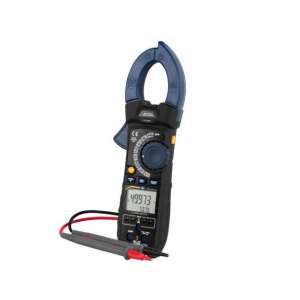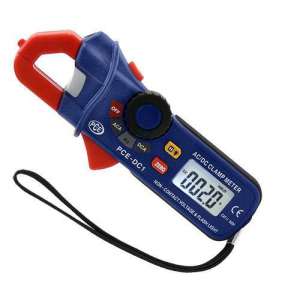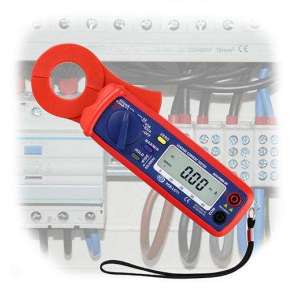Electrical measurement
Electrical measuring instruments are all the devices used to measure electrical quantities and thus ensure the proper functioning of electrical installations and machines. Most are portable handheld devices and are used for assembly; there are other instruments that are measurement converters to aid measurement, analysis and review. The collection of data is becoming increasingly important in the industrial, professional and private spheres. Above all, practical measuring instruments are in demand, which operate quickly and accurately and which offer results during measurement.
Electrical measurements are the methods of measuring electrical quantities. Measuring electrical quantities can be done by measuring electrical parameters of a system. Using transducers, physical properties such as temperature, pressure, flow, force, and many others can be converted into electrical signals, which can be conveniently recorded and measured. There are many different types of electrical measurement instruments, the most outstanding being ammeters, voltmeters, ohmeters, multimeters and currently the network analyzer is in use whose mission is to give a general idea of the consumption of the installation where it is installed.
Some of the most used equipment are:
Ammeters.
An ammeter is an instrument used to measure the intensity of current that is circulating through an electrical circuit. In their original design, the ammeters are essentially constituted by a galvanometer whose scale has been graduated in amps. Currently, ammeters use an analog/digital converter to measure the voltage drop on a resistor through which the current to be measured circulates. The converter reading is read by a microprocessor that performs the calculations to present on a numerical display the value of the circulating current.
To measure the intensity of the circulating current, the ammeter must be placed in series, so that it is crossed by this current. Special care should be taken, when using an analog Ammeter, when performing a current measurement. By the terminal where you indicate the magnitude to be measured (in this case A or mA), it must be connected in the part of the circuit where "enter the current to be measured", and the COM terminal must be connected in the remaining part of the circuit that was interrupted to make the measurement of the current. Otherwise, the measurement in this way will be made, the needle will deflect in the opposite direction to that established by the instrument, causing the possible breakage of the needle. This means that the ammeter must have an internal resistance as small as possible, so that it does not produce an appreciable voltage drop. For this, in the case of instruments based on the electromagnetic effects of electric current, they are equipped with coils of thick wire and with few loops.
Voltmeters
Electromechanical voltmeters: in essence, they are constituted by a galvanometer whose scale has been graduated in volts. There are models that separate the direct and alternating currents from the signal, being able to measure them independently. A voltmeter is an instrument used to measure the difference in potential or voltage between two points of a closed electrical circuit, but at the same time open at the poles. Voltmeters are classified by their mechanical operation, being in all cases the same instrument:
Electronic voltmeters: add an amplifier to provide higher input impedance and higher sensitivity.
Vector voltmeters: used with microwave signals. In addition to the voltage module they give an indication of its phase.
Digital voltmeters: give a numerical indication of the voltage, usually on an LCD screen. They usually have additional features such as memory, peak value detection, true effective value (RMS), automatic range selection and other functionalities.
To measure the potential difference, the voltmeter must be placed in parallel, that is, in derivation on the points between which the measurement is to be made. For this, in the case of instruments based on the electromagnetic effects of electric current, they are equipped with coils of very fine wire and with many loops, so that with low intensity of current through the device the necessary force is achieved for the displacement of the indicator needle.
Ohmmeter
There are also other types of more accurate and sophisticated oometers, in which the battery has been replaced by a circuit that generates a current of constant intensity I, which is circulated through the resistance R under test. A precision oometer has four terminals, called Kelvin contacts. Two terminals carry the constant current from the meter to the resistor, while the other two allow the measurement of the voltage directly between terminals of the same, so that the voltage drop in the conductors that apply this constant current to the resistance under test does not affect the accuracy of the measurement. An ohmmeter or ohmmeter is an instrument for measuring electrical resistance. The design of an oometer consists of a small battery to apply a voltage to the resistance under measurement, and then by means of a galvanometer measure the current that circulates through the resistance. The scale of the galvanometer is calibrated directly in ohms, since, in application of Ohm's law, being the voltage of the battery fixed, the current circulating through the galvanometer will only depend on the value of the resistance under measure, that is, the lower the resistance, the greater the current intensity and vice versa.
Tester.
There are also multimeters with advanced functions and measure current that allow: generate and detect the intermediate frequency of an apparatus, as well as an amplifier circuit with speaker to help in the tuning of circuits of these devices; signal tracking through all stages of the receiver under test; perform the function of oscilloscope above one million samples per second in scanning speed, and very high resolution; synchronize with other measuring instruments, including other multimeters, to make point power measurements (power = voltage * intensity); be used as a telephone device, in order to be able to connect to a telephone line under test, while measurements are being carried out by the same or by an adjacent telephone line; perform checks of automotive electronics circuits and recording of high or low voltage bursts. A multimeter, also called a polymeter or tester, is an instrument that offers the possibility of measuring different magnitudes in the same device. The most common are those of voltmeter, ammeter and oometer. It is frequently used by technical staff across the range of electronics and electricity. There are different models that incorporate in addition to the three basic functions mentioned above other important measurements, such as measurement of inductances and capacitances; diode and transistor tester; or scales and sockets for temperature measurement by means of standard thermocouples.
Power or network analyzer.
Here you can find the power analyzer to display power in watts or to analyze and measure harmonics. This power analyzer is a multifunction device that accurately measures direct current, alternating current, DC current intensity, AC current intensity and power in watts. The result of measuring AC power is considered as the actual value, where the maximum range is 4000 watts. During the measurement of the power the polarity changes automatically, if negative measurement values are produced a minus symbol will appear on the indicator of the power analyzer.
Pinza amperimétrica PCE-DC 50

Product Data Sheet:
Price:
€278.18 (inc. VAT)Pinza amperimétrica PCE-DC1

Product Data Sheet:
Price:
€93.05 (inc. VAT)Pinza amperimétrica PCE-LCT 1

Product Data Sheet:
Price:
€216.47 (inc. VAT)




